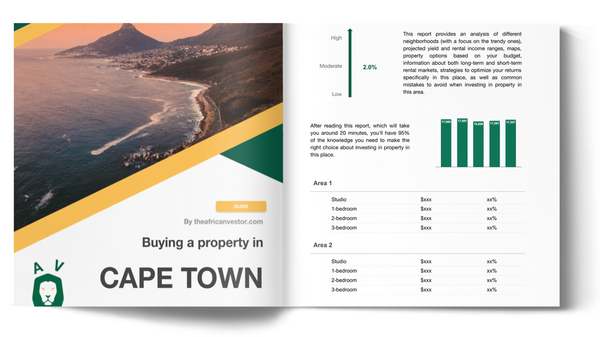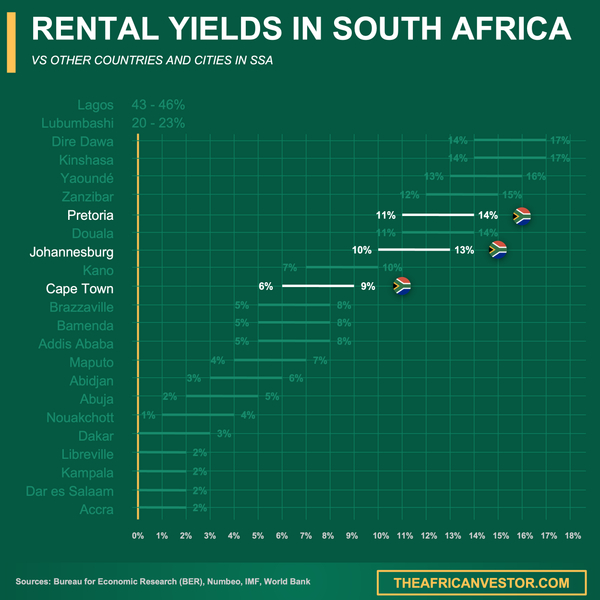Authored by the expert who managed and guided the team behind the South Africa Property Pack

Yes, the analysis of Cape Town's property market is included in our pack
Cape Town offers distinct neighborhoods with varying property prices, safety levels, and lifestyle amenities that directly impact investment potential and quality of life. Understanding the rental costs, purchase prices, and neighborhood characteristics is essential for making informed property decisions in this diverse South African city.
If you want to go deeper, you can check our pack of documents related to the real estate market in South Africa, based on reliable facts and data, not opinions or rumors.
Cape Town's best neighborhoods for property investment range from the premium City Bowl and Atlantic Seaboard areas commanding R30,000-R55,000 per square meter, to emerging areas like Woodstock offering R15,000-R22,000 per square meter with strong growth potential.
Central neighborhoods provide the best walkability and public transport access, while outer suburbs offer more space but require car dependency for daily activities.
| Neighborhood Type | Average Price per sqm | One-bedroom Rent | Commute to CBD | Public Transport |
|---|---|---|---|---|
| City Bowl (Gardens, CBD) | R30,000-R55,000 | R10,000-R16,000 | 5-15 minutes | Excellent |
| Atlantic Seaboard (Green Point, Sea Point) | R35,000-R55,000 | R12,000-R16,000 | 10-20 minutes | Very Good |
| Southern Suburbs (Claremont, Constantia) | R20,000-R35,000 | R8,000-R14,000 | 20-35 minutes | Good |
| Northern Suburbs (Durbanville, Bellville) | R18,000-R30,000 | R7,000-R12,000 | 25-40 minutes | Limited |
| Emerging Areas (Woodstock, Observatory) | R15,000-R25,000 | R8,000-R13,000 | 10-25 minutes | Good |

How much does it cost on average to rent a one-bedroom apartment in Cape Town's best neighborhoods?
Cape Town's rental market shows significant variation depending on the specific neighborhood you choose.
In the most sought-after central areas like City Bowl and Green Point, one-bedroom apartment rents range from R10,000 to R16,000 per month as of September 2025. These premium locations command higher prices due to their proximity to business districts and entertainment hubs.
The Atlantic Seaboard neighborhoods, particularly Sea Point and Camps Bay, typically fall within the R12,000 to R16,000 range for one-bedroom units. Properties with ocean views or modern amenities can exceed R16,000 monthly.
Southern Suburbs like Claremont and Rondebosch offer more affordable options at R8,000 to R14,000 per month, while Northern Suburbs such as Durbanville provide budget-friendly alternatives at R7,000 to R12,000 monthly.
Emerging neighborhoods like Woodstock and Observatory present middle-ground options at R8,000 to R13,000 per month, offering good value for money with strong growth potential.
What is the average purchase price per square meter for residential properties in Cape Town's neighborhoods?
Cape Town's property purchase prices vary dramatically across different neighborhoods, reflecting the city's diverse real estate landscape.
The City Bowl and Atlantic Seaboard command the highest prices at R30,000 to R55,000 per square meter for modern residential units. Luxury properties in these areas can exceed R55,000 per square meter, particularly those with ocean views or historical significance.
Southern and Northern Suburbs offer more moderate pricing at R18,000 to R30,000 per square meter for standard homes and apartments. These areas provide excellent value for families seeking larger properties with good school access.
Emerging neighborhoods like Woodstock and Salt River present the best entry-level investment opportunities at R15,000 to R22,000 per square meter. These areas have experienced strong appreciation in recent years, making them attractive for investors seeking growth potential.
Observatory and surrounding areas fall within the R15,000 to R25,000 range, offering a balance between affordability and proximity to the city center.
How have property values changed in Cape Town neighborhoods over the past five years?
Cape Town's property market has demonstrated strong growth across most neighborhoods since 2020.
Citywide property values have increased by approximately 141% since 2010, with annual average growth of 7-10% in prime areas and 4-5% more generally since 2020. This consistent appreciation makes Cape Town an attractive long-term investment destination.
Sea Point, Camps Bay, and other Atlantic Seaboard locations have experienced standout performance with annual growth rates of 5-8% over the past five years. These premium coastal areas continue to attract both local and international buyers.
Emerging neighborhoods like Woodstock and Observatory have shown exceptional appreciation, with some areas experiencing annual growth rates exceeding 8% since 2020. These districts benefit from urban regeneration projects and increasing demand from young professionals.
It's something we develop in our South Africa property pack.
What is the average household income level in Cape Town's different neighborhoods?
Household income levels across Cape Town neighborhoods reflect the city's economic diversity and influence property demand patterns.
The citywide average household income stands at R13,164 per month, though this figure varies significantly by neighborhood. Recent surveys suggest that mid-to-upper income areas typically see household incomes of R30,000 to R50,000 per month.
Atlantic Seaboard and City Bowl neighborhoods attract the highest-earning residents, with many households exceeding R50,000 monthly. These areas house professionals working in finance, legal services, and executive positions.
Southern Suburbs like Constantia and Bishopscourt host some of Cape Town's wealthiest residents, with household incomes often exceeding R70,000 per month. These neighborhoods attract established families and business owners.
Northern Suburbs present mixed income levels, with newer developments attracting middle-class families earning R25,000 to R45,000 monthly. Emerging areas like Woodstock increasingly attract young professionals with incomes of R20,000 to R40,000 per month.
How safe are Cape Town's neighborhoods compared to the city average?
Safety levels vary significantly across Cape Town neighborhoods, making location selection crucial for property buyers and renters.
| Neighborhood Type | Safety Rating | Key Crime Concerns |
|---|---|---|
| City Bowl (Gardens, Tamboerskloof) | Above Average | Petty theft, some drug-related incidents |
| Atlantic Seaboard (Green Point, Sea Point) | Good | Occasional break-ins, tourist-targeted crime |
| Southern Suburbs (Constantia, Claremont) | Very Good | Minimal violent crime, some property crime |
| Northern Suburbs (Durbanville, Bellville) | Good | Vehicle crime, occasional residential break-ins |
| Emerging Areas (Woodstock, Observatory) | Below to Average | Street crime, drug-related incidents |
| CBD and surrounding areas | Below Average | High crime rates, especially after hours |
Cape Town as a city has high violent crime rates compared to other major metros, but specific neighborhoods like the Atlantic Seaboard and Southern Suburbs maintain notably safer environments.
Don't lose money on your property in Cape Town
100% of people who have lost money there have spent less than 1 hour researching the market. We have reviewed everything there is to know. Grab our guide now.

How long does it take to commute from Cape Town neighborhoods to the city center?
Commute times from different Cape Town neighborhoods to the city center vary based on transport mode and traffic conditions.
Central neighborhoods including Gardens, Green Point, and Woodstock offer the shortest commutes at just 5-20 minutes by car and often under 30 minutes by public transport. These areas provide maximum convenience for professionals working in the CBD.
Atlantic Seaboard locations like Sea Point and Camps Bay typically require 10-25 minutes to reach the city center by car, depending on traffic conditions. Public transport options are good but may take 25-40 minutes during peak hours.
Southern Suburbs such as Claremont and Constantia generally involve 20-40 minute commutes by car. The train line provides alternative transport but can be unreliable during certain periods.
Northern Suburbs like Durbanville and Bellville typically require 25-45 minutes to reach the city center, with limited public transport options making car ownership essential for most residents.
How well are Cape Town neighborhoods connected by public transport?
Public transport connectivity across Cape Town neighborhoods determines both daily convenience and property values.
Central and dense areas including City Bowl, Green Point, and Woodstock benefit from excellent public transport through MyCiTi buses, train lines, and frequent minibus taxis. These neighborhoods offer multiple transport options with regular schedules.
Atlantic Seaboard areas are well-served by MyCiTi bus routes and have good taxi connectivity, though some coastal areas may have limited late-night options. The infrastructure supports car-free living for many residents.
Southern Suburbs maintain decent public transport through train connections and bus routes, though services can be inconsistent. Many residents combine public transport with private vehicle use for optimal mobility.
Northern Suburbs have more limited public transport coverage, especially beyond 10 km from the CBD. Residents in these areas typically depend on private vehicles for daily transportation needs.
Emerging areas like Observatory and Salt River are experiencing improved connectivity as infrastructure development follows residential growth.
How many schools are available within 5 km of Cape Town neighborhoods?
Educational facilities within Cape Town neighborhoods significantly influence family housing decisions and property values.
Central neighborhoods and Southern Suburbs offer multiple schools within 5 km radius, including prestigious institutions like German International School, Star College, and St Cyprian's. These areas typically host 5-7 top-rated schools with ratings of 4+ out of 5.
Southern Suburbs particularly excel in educational options, with areas like Constantia and Claremont providing access to both excellent public and private schools. International schools are well-represented in these neighborhoods.
City Bowl neighborhoods offer good school access, with several quality institutions within walking distance. The concentration of private and international schools makes these areas attractive to expatriate families.
Northern Suburbs provide adequate school options, with newer developments often built around educational facilities. Family-oriented suburbs like Durbanville host multiple primary and secondary schools.
Atlantic Seaboard areas have fewer schools due to high property costs, but residents typically access quality institutions in nearby neighborhoods.

We did some research and made this infographic to help you quickly compare rental yields of the major cities in South Africa versus those in neighboring countries. It provides a clear view of how this country positions itself as a real estate investment destination, which might interest you if you're planning to invest there.
What percentage of green spaces and parks are available in Cape Town neighborhoods?
Cape Town maintains one of the highest proportions of green spaces among South African cities, though distribution varies by neighborhood.
The city benefits from iconic green spaces including Company's Garden in the city center and Table Mountain National Park, which provides natural recreation areas accessible to most neighborhoods. This natural backdrop significantly enhances quality of life across the city.
City Bowl and Atlantic Seaboard neighborhoods enjoy excellent access to both urban parks and natural areas, with residents typically within 10 minutes of significant green spaces. The proximity to Table Mountain and Signal Hill provides extensive outdoor recreation opportunities.
Southern Suburbs offer some of Cape Town's most verdant residential areas, with neighborhoods like Constantia and Newlands featuring extensive private gardens and nearby wine estates. These areas maintain park-like environments with mature trees and landscaped spaces.
Northern Suburbs vary in green space availability, with newer developments often incorporating parks and recreational areas into their planning. Established areas may have less green space due to denser development patterns.
Emerging neighborhoods are experiencing green space development as urban regeneration projects incorporate parks and public spaces into community planning.
How many restaurants, shops, and essential services are within walking distance of Cape Town neighborhoods?
Walkable amenities significantly impact daily life quality and property desirability across Cape Town neighborhoods.
Central areas including City Bowl and Atlantic Seaboard provide extensive walkable amenities with groceries, cafes, restaurants, and essential services available on most blocks. Residents can access multiple dining options, shopping centers, and professional services within 5-10 minutes' walk.
Sea Point stands out for its restaurant scene along the beachfront, while Gardens offers boutique shopping and professional services. Green Point provides excellent access to the V&A Waterfront entertainment and shopping complex.
Southern Suburbs offer good walkable amenities within neighborhood centers, though residents may need to travel to specific commercial areas for extensive shopping. Areas like Claremont and Rondebosch have well-developed commercial districts.
Northern Suburbs typically feature car-dependent layouts with amenities concentrated in strip malls and shopping centers within 1-2 km of residential areas. While well-provided, these areas require vehicle access for convenience.
It's something we develop in our South Africa property pack.
What is the population density of Cape Town neighborhoods compared to others?
Population density across Cape Town neighborhoods reflects development patterns and lifestyle preferences that influence property demand.
Cape Town's citywide average population density stands at approximately 1,530 people per square kilometer, but individual neighborhoods vary significantly from this baseline.
City Bowl and Green Point represent the highest density areas at 4,000-6,000 people per square kilometer, reflecting apartment-style living and mixed-use development. These areas appeal to young professionals and those seeking urban convenience.
Atlantic Seaboard neighborhoods maintain moderate to high density due to apartment buildings and townhouse developments, typically ranging from 2,500-4,500 people per square kilometer. The coastal location drives demand despite limited space.
Southern and Northern Suburbs feature lower population densities, often below 1,000 people per square kilometer in areas with large residential plots and single-family homes. These areas attract families seeking space and privacy.
Emerging neighborhoods like Woodstock are experiencing density increases as redevelopment transforms former industrial areas into mixed-use communities with apartment buildings and converted warehouses.
What percentage of residents are owners versus renters in Cape Town neighborhoods?
Ownership patterns across Cape Town neighborhoods indicate investment potential and community stability.
Citywide statistics show approximately 50-55% owner-occupiers and 45-50% renters as of September 2025, though individual neighborhoods deviate significantly from these averages.
Central and new development-heavy areas including Woodstock and the CBD maintain higher rental percentages, often 60-70% renters. These areas attract young professionals, students, and temporary residents who prefer rental flexibility.
Southern Suburbs typically show higher ownership rates, with established family neighborhoods like Constantia and Claremont reaching 60-70% owner-occupiers. These areas appeal to families seeking long-term stability and good schools.
Atlantic Seaboard neighborhoods present mixed patterns, with some areas having high rental proportions due to vacation properties and investment units, while others maintain strong owner-occupier communities.
Northern Suburbs generally favor ownership, with many developments specifically designed for families purchasing their primary residences. New housing estates often see 70-80% owner-occupancy rates.
It's something we develop in our South Africa property pack.
Conclusion
This article is for informational purposes only and should not be considered financial advice. Readers are advised to consult with a qualified professional before making any investment decisions. We do not assume any liability for actions taken based on the information provided.
Cape Town's neighborhood diversity offers opportunities for various investment strategies and lifestyle preferences.
Success in Cape Town's property market requires understanding local dynamics, from safety considerations to transport connectivity, while balancing investment potential with personal needs.
